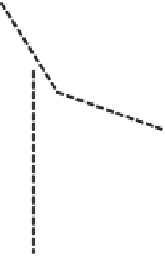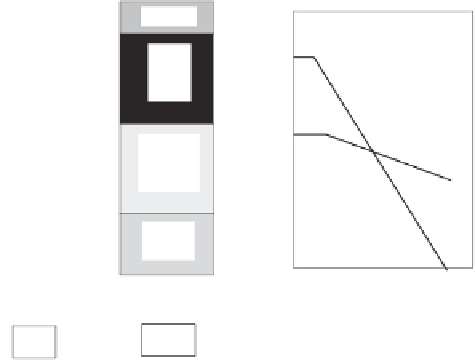Environmental Engineering Reference
In-Depth Information
another way, the cover material must be able to provide suffi-
cient water storage capacity and thermal energy to evaporate
water. These conditions must be met throughout each year.
It is necessary to test the functionality of the cover by sub-
jecting a proposed design to several years of past climatic
conditions. The cover may be subjected to 10 or more years
of past climatic record data. The numerical simulations may
be reduced to time steps and as a result the analysis becomes
computationally intensive. The concept of “storing water”
and “releasing water” throughout the year is relatively sim-
ple; however, the analysis is dependent on the assessment of
many variables as well as the estimation of several nonlinear
unsaturated soil property functions.
Log soil suction,
1
Topsoil
Topsoil
Finer
soil
layer
Finer
soil
Fine-
grained
soil
layer
Coarser
soil
layer
Interim
cover
Interim
cover
Coarser
soil
Monolithic
cover
Capillary
barrier
6.4.2 Classification of Alternative Cover Systems
Alternative covers can be classified into two main cate-
gories: (i) monolithic covers (MCs) and (ii) capillary barrier
covers (CBCs). Monolithic covers are also referred to as
store-and-release covers, soil-plant covers, ET covers, or
phytocovers or vegetated covers.
The MCs usually consist of a single, relatively thick layer
of fine-textured soil with a relatively high water storage
capacity. Alternative cover design requires there to be suf-
ficient evaporative flux potential for the removal of water
from the storage layer.
The CBCs usually take the form of two main layers. There
will often be an additional organic layer placed on top of
the basic cover layers. The primary cover material usually
consists of a fine-textured soil overlying a relatively coarse
soil layer. The coarse layer is meant to function as a capil-
lary break layer in order for the cover to function properly.
The design criteria that must be met are shown in Fig. 6.56.
The first design criterion states that the matric suction at the
interface between the fine and coarse soil layers must always
remain higher than the intersection of the permeability func-
tions for the two materials. Failure to meet this criterion
results in unwanted infiltration. The second design criterion
states that the matric suction at the interface between the
fine and coarse soil layers must be kept greater than the
residual suction of the coarse layer. These two criteria are
illustrated on the permeability functions shown for the fine
and coarse soil layers (Fig. 6.56).
Alternative covers have rapidly gained popularity due to
lower susceptibility to cracking and ability to accommodate
a wider range of materials. The concept behind the design of
alternative covers is simple and easy to grasp since the focus
is on the storage of water. However, the design verification
analysis is quite complex and involves a day-by-day numeri-
cal simulation of typical climatic data. There is a wide range
of possible soil cover materials that might possibly be used
for soil layers. Once the alternative cover is constructed
it usually has low postclosure maintenance requirements.
There should, however, be postclosure studies to verify that
the cover system is indeed functioning as it was designed
to function.
Suction >
residual
CBC
MC
Figure 6.56
Concept of a “capillary break” used in the design of
alternative cover systems.
SWCCs become the primary soil information required
for alternative cover designs. There are two breaks on the
SWCC that largely define the behavior of the soils upon
desaturation: (i) air-entry value of the soil and (ii) residual
suction of the soil. The SWCC for the soil defines the water
storage capabilities of the cover system.
The infiltration and transmission abilities of the cover sys-
tem are largely dependent upon the permeability function for
the soil (i.e., hydraulic conductivity versus soil suction). The
permeability function for the cover material (and the under-
lying material) is also a function of the saturated hydraulic
permeability and the SWCC of the soil.
The design of a cover system appears to be a relatively
straightforward application of unsaturated soil mechanics
principles. The inherent simplicity and straightforward con-
cepts associated with the theory and design of cover systems
can lead to unwarranted confidence in the design proce-
dure. The cover system must serve the purpose of being an
interceptor between the soil and the atmosphere. The cover
systems are called upon to perform satisfactorily under an
extremely wide range of diverse moisture and thermal flux
boundary conditions.
Another class of cover systems is known as “innovative
covers.” Innovative covers are classified mainly in terms of
their state of development. In other words, innovative covers
are still deemed to be at a fundamental stage of research
and development. Examples of innovative covers are clay
membrane barriers and polymer-clay nanocomposites with
superior mechanical, thermal, and electrical properties.
6.4.3 Geotechnical Aspects That Give Rise
to Modeling Challenges
There are several aspects of the cover design procedure that
make the procedure an engineering challenge. The infiltra-
tion modeling involves the solution of a highly nonlinear



















Search WWH ::

Custom Search